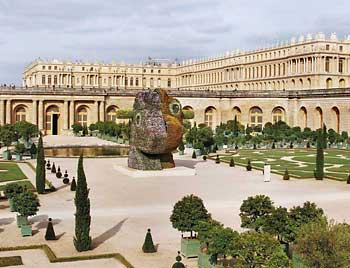The above video is excerpted from the Season 5 episode Fantasy, premiering on Wednesday, October 14, 2009 at 10pm (ET) on PBS (check local listings). Fantasy presents four artists — Cao Fei, Mary Heilmann, Jeff Koons, and Florian Maier-Aichen — whose hallucinatory, irreverent, and sublime works transport us to imaginary worlds and altered states of consciousness.
Who is Jeff Koons and what does he have to say about fantasy?
Jeff Koons was born in 1955 in York, Pennsylvania; he lives and works in New York. Koons plucks images and objects from popular culture, framing questions about taste and pleasure. His contextual sleight-of-hand, which transforms banal items into sumptuous icons, takes on a psychological dimension through dramatic shifts in scale, spectacularly engineered surfaces, and subliminal allegories of animals, humans, and anthropomorphized objects. The subject of art history is a constant undercurrent, whether Koons elevates kitsch to the level of Classical art, produces photos in the manner of Baroque paintings, or develops public works that borrow techniques and elements of seventeenth-century French garden design. Organizing his own studio production in a manner that rivals a Renaissance workshop, Koons makes computer-assisted, handcrafted works that communicate through their meticulous attention to detail.
On the subject of fantasy in art, Koons discusses the inspiration for his work Puppy (in the forthcoming Season 5 book):
After the French Revolution, artists had all the freedom they wanted to use art in any manner. But Louis XIV was a symbol of what happens to art under a monarch (whoever controls it, it will eventually reflect his or her ego and simply become decorative). I was making reference to that because if I wanted that responsibility or had that opportunity, the same thing would eventually happen. Puppy (1992) is a large floral sculpture made out of 60,000 large flowers. I conceived that piece really thinking that it would be the type of work that Louis would have the fantasy for. He’d wake up in the morning, look out of his palace window, and think, “What do I want to see today? I want to see a puppy, and I want to see it made out of 60,000 plants, and I want to see it by this evening. Go to it!” And he would come home that night and voilà, there it would be!
What happens in Koons’s segment in Fantasy this October?
“Art should be something really powerful,” says Jeff Koons, “but at the same time, there’s morality that comes along with that.” Koons argues that “objects are metaphors for people” and views art as a vehicle for communication that “can connect you through history” and empower viewers to accept their own pasts, cultures and desires.
The segment begins in the artist’s busy studio in Manhattan, where his computer-aided but hand-made paintings and sculptures develop slowly, with a large team of dedicated assistants, in the manner of a Renaissance workshop or atelier. The segment shifts to a major retrospective at the MCA Chicago (2008), where Koons provides a detailed analysis of two carved wood sculptures—Bear and Policeman and Ushering in Banality (both 1998)—as exemplifying the ethical and spiritual dimensions of art.
The segment concludes outside Paris at the Chateau de Versailles, where Koons is the first contemporary American artist to have a solo exhibition (2008-09), showcasing the mathematical planting of the giant flower topiary Split Rocker (2000). Koons imagines his Self-Portait (1991) bust as having a conversation with King Louis XIV, and compares his own attention to detail—in the works Michael Jackson and Bubbles (1998), Balloon Dog (Magenta) (1994-2000), and Lobster (2003)—to the joyous decoration of the palace’s period rooms and gardens.

Jeff Koons. "Split-Rocker," 2000. Installation view of "Jeff Koons Versailles," October 9, 2008-April 1, 2009, Chateau de Versailles, France. Stainless steel, soil, geotextile fabric, internal irrigation system, and live flowering plants, 441 x 465 x 426 inches. © Jeff Koons, courtesy the artist.
What else has Koons done?
Jeff Koons studied at the Art Institute of Chicago, and received a BFA from the Maryland Institute College of Art, Baltimore (1976), and honorary doctorates from the School of the Art Institute of Chicago (2008) and Corcoran College of Art + Design, Washington, D.C. (2002). Among the awards he has received are Officier of the French Legion of Honor (2007); the Artistic Achievement Award from Americans for the Arts (2006); and the Skowhegan Medal for Sculpture (2002). Recent major exhibitions have appeared at Château de Versailles, France (2008); the Metropolitan Museum of Art, New York (2008); Museum of Contemporary Art, Chicago (2008); Neue Nationalgalerie, Berlin (2008); Victoria and Albert Museum, London (2006); the Guggenheim Museum, New York (2002), and other institutions. Koons has participated in the Bienal de São Paulo (2002); Venice Biennale (1990, 1997); Sydney Biennale (1990); and the Whitney Biennial (1987, 1989). He was elected as a Fellow to the American Academy for Arts and Sciences in 2005.
Where can I see more of Koons’s work between now and the Art21 premiere this October?
Jeff Koons maintains an extensive website of his own work. His recent Popeye Series can be seen in London until September 13 at the Serpentine Gallery.
What’s your take on Koons’s inclusion in Season 5?
Tell us what you think by leaving a comment below!




Pingback: Season 5 Sneak Peek: Jeff Koons - BOMBLog
Pingback: What’s Cookin at the Art21 Blog: A Weekly Index | Art21 Blog